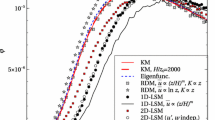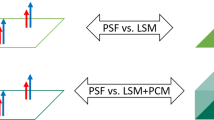Abstract
The ability of the relaxed eddy accumulation (REA) method to estimate the kinematic fluxes of temperature, water vapor and carbon dioxide was assessed for the dry season (3 months) at the ATTO (Amazon Tall Tower Observatory) site from turbulence measurements. The measurements were performed at 50 m above ground within the roughness sublayer. Non-conformity with inertial sublayer conditions was confirmed one more time by analyzing dimensionless scalar standard deviations. Over the scale of the whole dry season, REA and EC (eddy covariance) estimates are essentially equal. Recently found results that the REA method outperforms Monin–Obukhov-based approaches are confirmed. However, we also verify that such results fail to reveal significant variability and scatter of the REA estimates when the fluxes are of small magnitude. On the basis of previous studies, we conjecture that this is caused by a likely imbalance between scalar gradient production and molecular dissipation. Confirmation of our results to trace gases, therefore, requires further study.











Similar content being viewed by others
References
Allouche M, Bou-Zeid E, Ansorge C, Katul GG, Chamecki M, Acevedo O, Thanekar S, Fuentes JD (2022) The detection, genesis, and modeling of turbulence intermittency in the stable atmospheric surface layer. J Atmos Sci 79:1171–1190
Andreae MO, Acevedo OC, Araújo A, Artaxo P, Barbosa CGG, Barbosa HMJ, Brito J, Carbone S, Chi X, Cintra BBL, da Silva NF, Dias NL, Dias-Júnior CQ, Ditas F, Ditz R, Godoi AFL, Godoi RHM, Heimann M, Hoffmann T, Kesselmeier J, Könemann T, Krüger ML, Lavric JV, Manzi AO, Lopes AP, Martins DL, Mikhailov EF, Moran-Zuloaga D, Nelson BW, Nölscher AC, Santos Nogueira D, Piedade MTF, Pöhlker C, Pöschl U, Quesada CA, Rizzo LV, Ro CU, Ruckteschler N, Sá LDA, de Oliveira Sá M, Sales CB, dos Santos RMN, Saturno J, Schöngart J, Sörgel M, de Souza CM, de Souza RAF, Su H, Targhetta N, Tóta J, Trebs I, Trumbore S, van Eijck A, Walter D, Wang Z, Weber B, Williams J, Winderlich J, Wittmann F, Wolff S, Yáñez-Serrano AM (2015) The Amazon Tall Tower Observatory (ATTO): overview of pilot measurements on ecosystem ecology, meteorology, trace gases, and aerosols. Atmos Chem Phys 15:10723–10776. https://doi.org/10.5194/acp-15-10723-2015
Baker J, Norman J, Bland W (1992) Field-scale application of flux measurement by conditional sampling. Agric For Meteorol 62:31–52. https://doi.org/10.1016/0168-1923(92)90004-N
Bowling DR, Turnipseed AA, Delany A, Baldocchi DD, Greenberg JP, Monson R (1998) The use of relaxed eddy accumulation to measure biosphere-atmosphere exchange of isoprene and other biological trace gases. Oecologia 116:306–315. https://doi.org/10.1007/s004420050592
Bowling D, Delany A, Turnipseed A, Baldocchi D, Monson R (1999) Modification of the relaxed eddy accumulation technique to maximize measured scalar mixing ratio differences in updrafts and downdrafts. J Geophys Res Atmos 104:9121–9133. https://doi.org/10.1029/1999JD900013
Businger JA, Oncley SP (1990) Flux measurement with conditional sampling. J Atmos Ocean Technol 7:349–352. https://doi.org/10.1175/1520-0426(1990)007<0349:FMWCS>.0.CO;2
Cancelli DM, Dias NL, Chamecki M (2012) Dimensionless criteria for the production-dissipation equilibrium of scalar fluctuations and their implications for scalar similarity. Water Resour Res 48:W10522. https://doi.org/10.1029/2012WR012127
Chamecki M, Freire LS, Dias NL, Chen B, Dias-Junior CQ, Toledo Machado LA, Sörgel M, Tsokankunku A, Araújo A (2020) Effects of vegetation and topography on the boundary layer structure above the amazon forest. J Atmos Sci 77:2941–2957. https://doi.org/10.1175/JAS-D-20-0063.1
Chor TL, Dias NL, Araújo A, Wolff S, Zahn E, Manzi A, Trebs I, Sá MO, Teixeira PR, Sörgel M (2017) Flux-variance and flux-gradient relationships in the roughness sublayer over the Amazon forest. Agric For Meteorol 239:213–222. https://doi.org/10.1016/j.agrformet.2017.03.009
Desjardins RL (1972) A study of carbon-dioxide and sensible heat fluxes using the eddy correlation technique. Ph.D. thesis, Cornell University
Desjardins RL (1977) Description and evaluation of a sensible heat flux detector. Boundary-Layer Meteorol 11:147–154. https://doi.org/10.1007/BF02166801
Dias NL (2013) Research on atmospheric turbulence by Wilfried Brutsaert and collaborators. Water Resour Res 49:7169–7184. https://doi.org/10.1002/wrcr.20461
Dias NL, Brutsaert W (1996) Similarity of scalars under stable conditions. Boundary-Layer Meteorol 80:355–373. https://doi.org/10.1007/BF00119423
Dias NL, Hong J, Leclerc M, Black Nesic Z, Krishnan P (2009) A simple method of estimating scalar fluxes over forests. Boundary-Layer Meteorol 132:401–414. https://doi.org/10.1007/s10546-009-9408-0
Dias-Júnior CQ, Dias NL, dos Santos RMN, Sörgel M, Araújo A, Tsokankunku A, Ditas F, de Santana RA, von Randow C, Sá M et al (2019) Is there a classical inertial sublayer over the amazon forest? Geophys Res Lett 46:5614–5622. https://doi.org/10.1029/2019GL083237
Edson JB, Fairall CW, Bariteau L, Zappa CJ, Cifuentes-Lorenzen A, McGillis WR, Pezoa S, Hare JE, Helmig D (2011) Direct covariance measurement of CO2 gas transfer velocity during the 2008 southern ocean gas exchange experiment: wind speed dependency. J Geophys Res Oceans 116:C00F10. https://doi.org/10.1029/2011JC007022
Fuentes JD, Chamecki M, dos Santos RMN, von Randow C, Stoy PC, Katul G, Fitzjarrald D, Manzi A, Gerken T, Trowbridge A, Freire LS, Ruiz-Plancarte J, Maia JMF, Tóta J, Dias NL, Fisch G, Schumacher C, Acevedo O, Mercer JR (2016) Linking meteorology, turbulence, and air chemistry in the amazon rainforest. Bull Am Meteorol Soc 97:2329–2342. https://doi.org/10.1175/BAMS-D-15-00152.1
Hill RJ (1989) Implications of Monin–Obukhov similarity theory for scalar quantities. J Atmos Sci 46:2236–2244. https://doi.org/10.1175/1520-0469(1989)046<2236:IOMSTF>2.0.CO;2
Katul G, Peltola O, Grönholm T, Launiainen S, Mammarella I, Vesala T (2018) Ejective and sweeping motions above a peatland and their role in relaxed-eddy-accumulation measurements and turbulent transport modelling. Boundary-Layer Meteorol 169:163–184. https://doi.org/10.1007/s10546-018-0372-4
McMillen RT (1988) An eddy correlation technique with extended applicability to non-simple terrain. Boundary-Layer Meteorol 43:231–245. https://doi.org/10.1007/BF00128405
Mochizuki T, Tani A, Takahashi Y, Saigusa N, Ueyama M (2014) Long-term measurement of terpenoid flux above a Larix kaempferi forest using a relaxed eddy accumulation method. Atmos Environ 83:53–61. https://doi.org/10.1016/j.atmosenv.2013.10.054
Mortarini L, Katul GG, Cava D, Dias-Junior CQ, Dias NL, Manzi A, Sorgel M, Araújo A, Chamecki M (2023) Adjustments to the law of the wall above an amazon forest explained by a spectral link. Phys Fluids. https://doi.org/10.1063/5.0135697
Ren X, Sanders J, Rajendran A, Weber R, Goldstein A, Pusede S, Browne E, Min KE, Cohen R (2011) A relaxed eddy accumulation system for measuring vertical fluxes of nitrous acid. Atmos Meas Tech 4:2093–2103. https://doi.org/10.5194/amt-4-2093-2011
Rhew RC, Deventer MJ, Turnipseed AA, Warneke C, Ortega J, Shen S, Martinez L, Koss A, Lerner BM, Gilman JB et al (2017) Ethene, propene, butene and isoprene emissions from a ponderosa pine forest measured by relaxed eddy accumulation. Atmos Chem Phys 17:13417–13438. https://doi.org/10.5194/acp-17-13417-2017
Santana RA, Dias-Júnior CQ, da Silva JT, Fuentes JD, do Vale RS, Alves EG, dos Santos RMN, Manzi AO (2018) Air turbulence characteristics at multiple sites in and above the amazon rainforest canopy. Agric For Meteorol 260:41–54. https://doi.org/10.1016/j.agrformet.2018.05.027
Sarkar C, Turnipseed A, Shertz S, Karl T, Potosnak M, Bai J, Serça D, Bonal D, Burban B, Lopes PR et al (2020) A portable, low-cost relaxed eddy accumulation (REA) system for quantifying ecosystem-level fluxes of volatile organics. Atmos Environ 242:117764. https://doi.org/10.1016/j.atmosenv.2020.117764
Webb EK, Pearman GI, Leuning R (1980) Correction of flux measurements for density effects due to heat and water vapor transfer. Q J R Meteorol Soc 106:85–100. https://doi.org/10.1002/qj.49710644707
Willmott CJ, Robeson SM, Matsuura K (2012) A refined index of model performance. Int J Climatol 32:2088–2094. https://doi.org/10.1002/joc.2419
Zahn E, Chor TL, Dias NL (2016) A simple methodology for quality control of micrometeorological datasets. Am J Environ Eng 6:135–142. https://doi.org/10.5923/s.ajee.201601.20
Zahn E, Dias NL, Araújo A, Sá LDA, Sörgel M, Trebs I, Wolff S, Manzi A (2016) Scalar turbulent behavior in the roughness sublayer of an Amazonian forest. Atmos Chem Phys 16:11349–11366. https://doi.org/10.5194/acp-16-11349-2016
Zahn E, Bou-Zeid E, Dias NL (2023) Relaxed eddy accumulation outperforms Monin–Obukhov flux models under non-ideal conditions. Geophys Res. https://doi.org/10.1029/2023GL103099
Zhu T, Pattey E, Desjardins R (2000) Relaxed eddy-accumulation technique for measuring ammonia volatilization. Environ Sci Technol 34:199–203. https://doi.org/10.1021/es980928f
Acknowledgements
This study is part of the Amazon Tall Tower Observatory (ATTO), funded by the German Federal Ministry of Education and Research (BMBF, contracts 01LB1001A and 01LK1602A), the Brazilian Ministry of Science, Technology and Innovation (MCTI/FINEP, contract 01.11.01248.00) and the Max Planck Society (MPG). ATTO is also supported by the Fundação de Amparo à Pesquisa do Estado do Amazonas (FAPEAM), Fundação de Amparo à Pesquisa do Estado de São Paulo (FAPESP), Universidade do Estado do Amazonas (UEA), Instituto Nacional de Pesquisas Amazônia (INPA), Programa de Grande Escala da Biosfera-Atmosfera na Amazônia (LBA) and the SDS/CEUC/RDS-Uatumã. Nelson Luís Dias gratefully acknowledges CNPq’s (Brazil’s National Research Council) Research Scholarship 305903/2021-7. Cléo Quaresma Dias-Júnior gratefully acknowledges CNPq’s (Brazil’s National Research Council) Research Scholarship 307530/2022-1.
Author information
Authors and Affiliations
Contributions
NLD conceived the overall research. NLD, IMCT, CQD, LM and DB all processed data and generated figures. NLD wrote the manuscript. All authors reviewed the manuscript.
Corresponding author
Ethics declarations
Conflict of interest
The authors declare no competing interests.
Additional information
Publisher's Note
Springer Nature remains neutral with regard to jurisdictional claims in published maps and institutional affiliations.
Rights and permissions
Springer Nature or its licensor (e.g. a society or other partner) holds exclusive rights to this article under a publishing agreement with the author(s) or other rightsholder(s); author self-archiving of the accepted manuscript version of this article is solely governed by the terms of such publishing agreement and applicable law.
About this article
Cite this article
Dias, N.L., Toro, I.M.C., Dias-Júnior, C.Q. et al. The Relaxed Eddy Accumulation Method Over the Amazon Forest: The Importance of Flux Strength on Individual and Aggregated Flux Estimates. Boundary-Layer Meteorol 189, 139–161 (2023). https://doi.org/10.1007/s10546-023-00829-7
Received:
Accepted:
Published:
Issue Date:
DOI: https://doi.org/10.1007/s10546-023-00829-7




